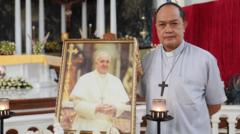As the sun shines on Vatican City, the second day of conclave voting resumes with cardinals evaluating candidates, yet black smoke signals that no pope has been elected. Following the death of Pope Francis, the cardinals convened, and on Wednesday evening, a lengthy ballot did not yield a majority. Starting Thursday, they will vote in secret, looking for a two-thirds majority to elect a new pontiff amid growing public anticipation.
**Cardinals Continue Voting Amid Black Smoke in Vatican Conclave**

**Cardinals Continue Voting Amid Black Smoke in Vatican Conclave**
No consensus reached yet as new pope selection process drags on with more votes expected.
On Thursday morning, black smoke emerged from the Sistine Chapel chimney, indicating ongoing discussions among the 133 voting cardinals who must reach a consensus on Pope Francis' successor. Following three hours of inconclusive voting on Wednesday, the assembly took a break for the afternoon to regroup before two additional rounds of voting scheduled for Thursday.
Onlookers in St. Peter's Square, brimming with anticipation, reacted to the smoke with disappointment, recognizing the wait for a new pope would continue. Observers note that this conclave, with its diverse lineup of cardinals, reflects a shift in dynamics, as many are unfamiliar with one another.
Procedurally, the cardinals, under the tradition known as "sede vacante," will initiate four rounds of voting daily until a candidate garners the necessary votes. Each ballot is meticulously traced, with the new pope's election signaling with white smoke, and continuous black smoke indicating the need for further deliberation.
The process has garnered worldwide attention, partly due to its recent historic significance. Past elections have varied widely in duration, ranging from a few hours to nearly three years, reflecting the myriad complexities of reaching an agreement.
As the conclave navigates through ideological divides within the church — between conservative factions loyal to tradition and progressive groups eager for change — the upcoming votes will remain pivotal for defining the future direction of the Catholic Church for millions of followers worldwide.
Onlookers in St. Peter's Square, brimming with anticipation, reacted to the smoke with disappointment, recognizing the wait for a new pope would continue. Observers note that this conclave, with its diverse lineup of cardinals, reflects a shift in dynamics, as many are unfamiliar with one another.
Procedurally, the cardinals, under the tradition known as "sede vacante," will initiate four rounds of voting daily until a candidate garners the necessary votes. Each ballot is meticulously traced, with the new pope's election signaling with white smoke, and continuous black smoke indicating the need for further deliberation.
The process has garnered worldwide attention, partly due to its recent historic significance. Past elections have varied widely in duration, ranging from a few hours to nearly three years, reflecting the myriad complexities of reaching an agreement.
As the conclave navigates through ideological divides within the church — between conservative factions loyal to tradition and progressive groups eager for change — the upcoming votes will remain pivotal for defining the future direction of the Catholic Church for millions of followers worldwide.





















